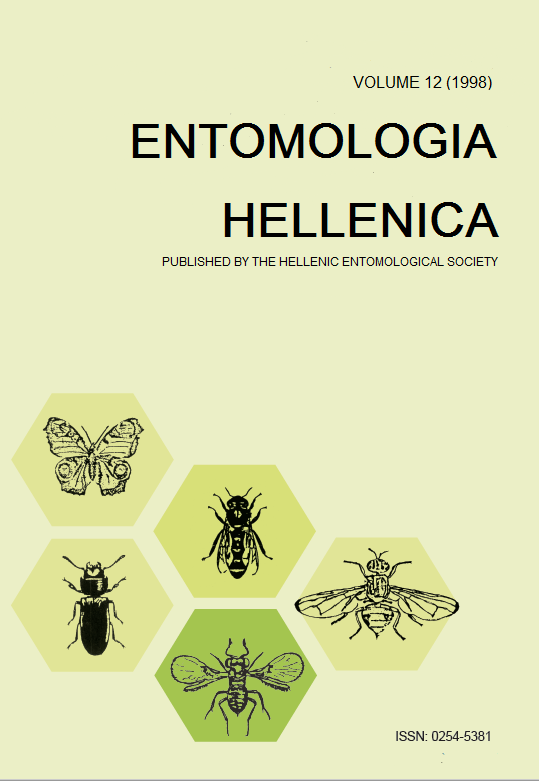Γεωγραφική Παραλλακτικότητα στην Πρόκληση και Περάτωση της Διάπαυσης του Ακάρεως Tetranychus urticae
Περίληψη
Σε οκτώ φυλές του ακάρεως Tetranychus urticae Koch (Acari: Tetranychidae) που προέρχονταν από διαφορετικές περιοχε'ς της Ευροόπης, η κρίσιμη φωτόφαση για την πρόκληση και περάτωση της διάπαυσης ήταν σχεδόν η ίδια σε κάθε φυλή, αλλά διέφερε ανάλογα με τη γεωγραφική προέλευση της φυλής. Η κρίσιμη φωτόφαση είχε μικρότερη διάρκεια σε φυλές που προέρχονταν από μικρά γεωγραφικά πλάτη και μεγαλύτερη διάρκεια σε φυλές από μεγάλα γεωγραφικά πλάτη. Η ένταση της διάπαυσης, μετρούμενη ως η απαιτούμενη περίοδος έκθεσης των διαπαυόντοον ατόμιον σε χαμηλές θερμοκρασίες για την περάτωση της διάπαυσης, διέφερε επίσης και ήταν μεγαλύτερη όσο μεγαλύτερο ήταν το γεωγραφικό πλάτος προέλευσης της φυλής. Κατ' εξαίρεση δυο φυλές
που προέρχονταν από ορεινές περιοχές, είχαν μεγαλύτερη τιμή κρίσιμης φωτόφασης και μεγαλύτερη ένταση διάπαυσης από ότι αναμενόταν με βάση το γεωγραφικό πλάτος προέλευσης τους. Ο αριθμός των φωτοπεριοδικών κΰκλοιν με μεγάλη διάρκεια φωτόφασης που απαιτούνταν για την περάτοιση της διάπαυσης στο 50% των ατόμων μετά από ορισμένη περίοδο ψύξης, ήταν μεγαλύτερος στις βόρειες και μικρότερος στις νότιες φυλές. Τα αποτελέσματα αυτά δείχνουν ότι γεωγραφικές φυλές του Τ. urticae μπορεί να διαφέρουν σε αξιόλογο βαθμό ως προς τα χαρακτηριστικά της διάπαυσης, κάτι που προφανούς αποτελεί μηχανισμό προσαρμογής σε τοπικές κλιματικές συνθήκες. Η μεγάλη πλαστικότητα των χαρακτηριστικών της διάπαυσης μπορεί, μεταξύ άλλων
παραγόνων, να είναι υπεύθυνη για την ευρεία γεωγραφική διάδοση του είδους αυτού.
Λεπτομέρειες άρθρου
- Πώς να δημιουργήσετε Αναφορές
-
Koveos, D. S., & Veerman, A. (1998). Γεωγραφική Παραλλακτικότητα στην Πρόκληση και Περάτωση της Διάπαυσης του Ακάρεως Tetranychus urticae. ENTOMOLOGIA HELLENICA, 12, 5–12. https://doi.org/10.12681/eh.14013
- Τεύχος
- Τόμ. 12 (1998)
- Ενότητα
- Articles

Αυτή η εργασία είναι αδειοδοτημένη υπό το CC Αναφορά Δημιουργού – Μη Εμπορική Χρήση – Παρόμοια Διανομή 4.0.
Authors who publish with this journal agree to the following terms:
Authors retain copyright and grant the journal right of first publication with the work simultaneously licensed under a Creative Commons 4.0 license.
Authors are able to enter into separate, additional contractual arrangements for the non-exclusive distribution of the journal's published version of the work (e.g. post it to an institutional repository or publish it in a book), with an acknowledgement of its initial publication in this journal. Authors are permitted and encouraged to post their work online (preferably in institutional repositories or on their website) prior to and during the submission process, as it can lead to productive exchanges, as well as earlier and greater citation of published work.



